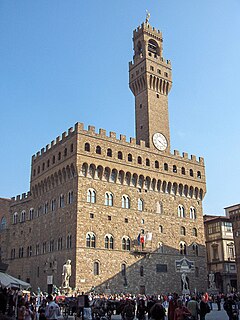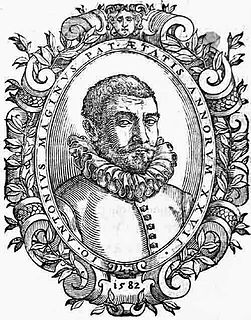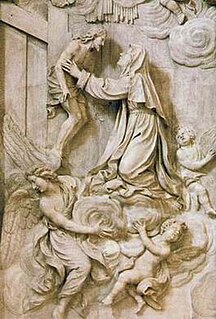
An armillary sphere is a model of objects in the sky, consisting of a spherical framework of rings, centred on Earth or the Sun, that represent lines of celestial longitude and latitude and other astronomically important features, such as the ecliptic. As such, it differs from a celestial globe, which is a smooth sphere whose principal purpose is to map the constellations. It was invented separately in ancient Greece and ancient China, with later use in the Islamic world and Medieval Europe.

The University of Pavia is a university located in Pavia, Lombardy, Italy. There was evidence of teaching as early as 1361, making it one of the oldest universities in the world. It was the sole university in Milan and the greater Lombardy region until the end of the 19th century.

Vincenzo Galilei was an Italian lutenist, composer, and music theorist, and the father of astronomer and physicist Galileo Galilei and the lute virtuoso and composer Michelagnolo Galilei. Vincenzo was a figure in the musical life of the late Renaissance and contributed significantly to the musical revolution which demarcates the beginning of the Baroque era.

The Basilica di Santa Croce is the principal Franciscan church in Florence, Italy, and a minor basilica of the Roman Catholic Church. It is situated on the Piazza di Santa Croce, about 800 meters south-east of the Duomo. The site, when first chosen, was in marshland outside the city walls. It is the burial place of some of the most illustrious Italians, such as Michelangelo, Galileo, Machiavelli, the poet Foscolo, the philosopher Gentile and the composer Rossini, thus it is known also as the Temple of the Italian Glories.

The Palazzo Vecchio is the town hall of Florence, Italy. It overlooks the Piazza della Signoria, which holds a copy of Michelangelo's David statue, and the gallery of statues in the adjacent Loggia dei Lanzi.

Su Song was a Chinese polymathic scientist and statesman. Excelling in a variety of fields, he was accomplished in mathematics, astronomy, cartography, geography, horology, pharmacology, mineralogy, metallurgy, zoology, botany, mechanical engineering, hydraulic engineering, civil engineering, architecture, invention, art, poetry, philosophy, antiquities, and statesmanship during the Song Dynasty (960–1279).

Giovanni Antonio Magini was an Italian astronomer, astrologer, cartographer, and mathematician.

Lelio Orsi, also known as Lelio da Novellara, was a Mannerist painter and architect of the Reggio Emilia school in northern Italy.

Castelvecchio Museum is a museum in Verona, northern Italy, located in the eponymous medieval castle. Restoration by the architect Carlo Scarpa between 1959 and 1973 has enhanced the appearance of the building and exhibits. Scarpa's architectural style is visible in the details for doorways, staircases, furnishings, and even fixtures designed to hold a specific piece of artwork. The renovation carefully balanced new and old, revealing the history of the original building where appropriate. Unusual at the time, this approach has now become a common approach to renovation.

Ignazio Danti, O.P., born Pellegrino Rainaldi Danti, was an Italian Roman Catholic prelate, mathematician, astronomer, and cosmographer, who served as Bishop of Alatri (1583–1586).

Museo Galileo, the former Istituto e Museo di Storia della Scienza is located in Florence, Italy, in Piazza dei Giudici, along the River Arno and close to the Uffizi Gallery. The museum, dedicated to astronomer and scientist Galileo Galilei, is housed in Palazzo Castellani, an 11th-century building which was then known as the Castello d’Altafronte. Museo Galileo owns one of the world's major collection of scientific instruments, which bears evidence of the role that the Medici and Lorraine Grand Dukes attached to science and scientists. The Museo di Storia della Scienza re-opened to the public under the new name Museo Galileo on June 10, 2010, after a two-year closure due to redesigning and renovation works. It was inaugurated four hundred years after the publication in March 1610 of Galileo's Sidereus Nuncius.

Museo Nazionale Scienza e Tecnologia "Leonardo da Vinci" in Milan is the largest science and technology museum in Italy, and is dedicated to Italian painter and scientist Leonardo da Vinci. It was opened on 5 February 1953 and inaugurated by the prime minister of Italy, Alcide De Gasperi.
Castello di Volpaia is a winery located in the medieval village of Volpaia. The estate is over 900 acres (360 ha) divided between vineyards, olive groves, and woods. The winery is organically farmed for producing extra virgin olive oil, vinegar and wine, in particular Chianti Classico. The winery is owned by Carlo and Giovannella Mascheroni Stianti and helped by their son Nicolo' Mascheroni Stianti.
Paolo Galluzzi is an Italian historian of science.
Christoph Schissler was a German builder of high precision scientific instruments.

Brescia is a city and comune in the region of Lombardy in northern Italy. It is situated at the foot of the Alps, a few kilometres from the lakes Garda and Iseo. With a population of more than 200,000, it is the second largest city in the region and the fourth of northwest Italy. The urban area of Brescia extends beyond the administrative city limits and has a population of 672,822, while over 1.5 million people live in its metropolitan area. The city is the administrative capital of the Province of Brescia, one of the largest in Italy, with over 1,200,000 inhabitants.

Santucci's armillary sphere is a Ptolemaic armillary sphere at the Museo Galileo in Florence, the largest existing in the world.
Antonio Santucci (?–1613) was an Italian astronomer, cosmographer, and scientific instrument maker.

Girolamo Ticciati (1676–1744) was an Italian sculptor and architect.

The Reale Museo di Fisica e Storia Naturale was an Italian museum founded on February 22, 1775 in Florence that survived until 1878, when its collections were split up in various Florentine museums.
















